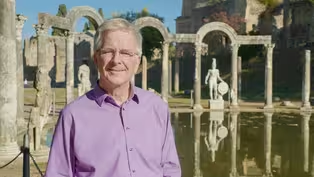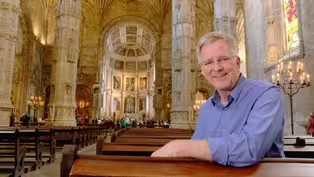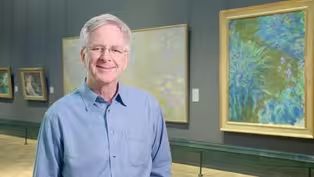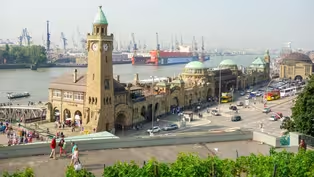Rick Steves' Europe
Rick Steves’ Europe: Baroque Art
Season 12 Episode 1209 | 28m 22sVideo has Closed Captions
We marvel at Baroque’s over-the-top churches, palaces, bubbly fountains, and theatric art.
Forged in Europe’s religious struggles, Baroque art inspired the faithful and dazzled the masses. We start in Rome, with its awe-inspiring St. Peter’s, fleshy Bernini statues and bubbly fountains. In Belgium, we see the dramatic canvases of Rubens. And finally: the ultimate Baroque palace, Versailles, with its chandeliered Hall of Mirrors and vast gardens where nobles played as Revolution brewed.
Problems playing video? | Closed Captioning Feedback
Problems playing video? | Closed Captioning Feedback
Distributed nationally by American Public Television
Rick Steves' Europe
Rick Steves’ Europe: Baroque Art
Season 12 Episode 1209 | 28m 22sVideo has Closed Captions
Forged in Europe’s religious struggles, Baroque art inspired the faithful and dazzled the masses. We start in Rome, with its awe-inspiring St. Peter’s, fleshy Bernini statues and bubbly fountains. In Belgium, we see the dramatic canvases of Rubens. And finally: the ultimate Baroque palace, Versailles, with its chandeliered Hall of Mirrors and vast gardens where nobles played as Revolution brewed.
Problems playing video? | Closed Captioning Feedback
How to Watch Rick Steves' Europe
Rick Steves' Europe is available to stream on pbs.org and the free PBS App, available on iPhone, Apple TV, Android TV, Android smartphones, Amazon Fire TV, Amazon Fire Tablet, Roku, Samsung Smart TV, and Vizio.
Providing Support for PBS.org
Learn Moreabout PBS online sponsorshipMore from This Collection
Rick Steves, America's leading authority on European travel, returns to transport viewers to the continent's bustling cities, quaint villages and picturesque countryside.
Rick Steves’ Europe: Art of the Roman Empire
Video has Closed Captions
The grand cities of ancient Rome’s vast empire and majestic churches of its fall. (28m 23s)
Rick Steves’ Europe: Art of the Renaissance Beyond Florence
Video has Closed Captions
From Portugal to Germany, booming economies and new technologies produce exquisite art. (28m 42s)
Rick Steves’ Europe: Art of the Impressionists and Beyond
Video has Closed Captions
Shimmering Impressionist canvases by Monet and Renoir, plus Van Gogh, Gauguin and more. (28m 26s)
Rick Steves’ Europe: Art of the Florentine Renaissance
Video has Closed Captions
Florence’s bold “rebirth” is powered by the genius of Leonardo, Rafael, and Michelangelo. (28m 3s)
Rick Steves’ Europe: Art of Prehistoric Europe
Video has Closed Captions
We marvel at Stone Age cave paintings, mighty megaliths, and mysterious goddesses. (28m 4s)
Germany's Hamburg and the Luther Trail
Video has Closed Captions
Hamburg, Germany’s mighty port city has risen from the ashes of World War II (26m 47s)
Providing Support for PBS.org
Learn Moreabout PBS online sponsorship- Hi, I'm Rick Steves, back with more of the best of Europe.
This time, rather than a particular place, we are going thematic and traveling anywhere that theme takes us.
This time, it's the art of the Baroque age.
You know, divine kings, pudgy-winged babies, and fancy fountains.
Thanks for joining us.
(light uptempo music) There's so much of Baroque Europe's art to be dazzled by, and understanding who paid for it and why makes it even splashier.
While the Renaissance was calm, composed, and intellectual, in this next stage, artists cranked up the drama, the emotions, and the energy in their art.
We'll start with the religious struggles that divided Europe, leading to both exuberant Catholic art designed to attract the faithful and dramatic secular art that made pulse's race.
We'll see how Bernini brought marble to life and how Caravaggio amped up the excitement.
France, with its divine right kings, emerged as the center of European culture.
And at the palace of palaces, Versailles, kings did their best to prove they were godlike.
And as the controlled exuberance of Baroque led to the uncontrolled exuberance of Rococo, all the queen could say was, "I just love this new dress."
(light orchestral music) From Baroque's birthplace in Rome, we follow it spread far and wide, venturing from Vienna and Germany to Belgium and France with Paris, Versailles and chateaus on the Loire.
The roots of Baroque go back to the 1500s to the turmoil of the Protestant Reformation.
People were questioning Europe's most powerful institution, the Roman Catholic Church.
This was big news, and art, the media of the day, told the story.
When a German monk named Martin Luther hammered 95 points for debate on this door, he opened a Pandora's box of issues from church corruption to the role of art in religion, to the legitimacy of the Pope, unleashing long pent-up frustrations.
Soon, the protestors, called Protestants, were breaking away from the traditional Catholic church.
This religious revolution, called the Reformation, plunged Europe into a century-long series of wars.
Each side expressed its intense passion through its art.
Here a Catholic nun wails on a bunch of sinful Protestants while a determined cherub rips pages from a Protestant book, and an angel wrestles with the serpent of heresy.
Artists captured the misery and the epic scale.
As religious wars spread, nearly a third of all Germans died.
War crimes became commonplace with each side convinced that God was on their side and that they were fighting the devil himself.
Paintings show how most of Europe was at war, swept up by powerful forces as if the fighting might go on forever.
After decades of war in 1648, an exhausted Europe reached an uneasy peace that enabled Protestants and Catholics to coexist, but it left Europe split into two camps.
Protestants, mainly in the northern countries, Catholics in the south.
Each with its own culture and style of art.
The art of the day was Baroque and it fit Catholic lands perfectly.
(uptempo orchestral music) The Baroque style, with its bright colors, big canvases, dramatic statues, exuberant architecture, and over-the-top ornamentation appealed to the emotions.
Put it all together, as Baroque artists love to do, and the ensemble packed a powerful message.
After all this turmoil, Catholic Europe craved stability, and the Baroque message was pro status quo.
Obey the Pope and the established order and things will be okay.
It's no wonder Baroque was the favorite style of Catholic rulers.
The Baroque style flourished in Rome, especially at the Vatican, the headquarters of the Catholic faith.
Art became a tool of the church.
To help reinvigorate the faith and counter the Protestant Reformation.
churches were made more welcoming with bright, spacious interiors and dazzling art.
Art that made complicated theology easier to understand.
The Grand Church of St. Peter's was decorated in the Baroque style to make a statement, The message?
To proclaim the legitimacy of the Roman Catholic faith as the one true faith, and the Pope as its leader.
The altar radiates these Catholic ideals, with sunlight pouring like the Holy Spirit through its alabaster window, illuminating the symbolic throne of the first Pope, St. Peter, and all the Popes since.
With its sheer size, 600 feet long, big enough for thousands of worshipers, colossal cupids and massive Baroque canopy, St. Peter's has given centuries of pilgrims and worshipers a glimpse of the heaven that awaited them if they stayed true to the faith.
The art and architecture of this age was also a powerful political tool.
The kings and queens of the day claimed they were ordained by God to rule without question.
These so-called divine monarchs used art as propaganda to convince their subjects that their authority was legit.
This magnificent German palace in Wurzburg was home to the so-called Prince Bishop.
He was a ruler with both secular and religious power.
It was built in the Baroque style and decorated in the even frillier Rococo style that followed.
As VIP guests arrived, they'd glide gracefully up the stairway, inspired by a grand fresco as it opened up overhead.
The Prince Bishop was the center of the cosmos, honored by the Greek gods and ruler of the four great continents, including a bare-chested figure of America seated on an alligator at a rowdy cannibal barbecue.
And Lady Europe points her brush to the center of all culture, the capital of his realm, Wurzburg.
(light orchestral music) Palaces of this age feature grandiose architecture with decoration that abhors a straight line and is full of motion.
Artists used mirrors and lavish gilding to enliven interiors.
They were masters of three-dimensional illusion, using all the tricks, from painting mathematically correct architecture, to fake shadows, all to give a believable sense of 3D reality.
Again, art of this period was pure marketing, paid for and serving either the church or the state.
Or in the Prince Bishop's case, both.
Here, the bishop is being empowered by the imperial scepter, reminding all that he was part of a divinely ordained and secular chain of command.
Big, colorful and melodramatic, Baroque art was also well-suited to the luxury-loving tastes of aristocrats.
Though they were devoted Christians, they also considered themselves enlightened and celebrated the classical or pre-Christian world of ancient Greece and Rome.
So besides religious themes, they enjoyed secular scenes, like epic tales of classical mythology.
Baroque art could be surprisingly risque.
There's lots of flesh, violence and rippling motion, intense passion, lots of trauma, and a sure sign of Baroque, pudgy-winged babies.
A great pioneer of Baroque was the dynamic Italian named Gian Lorenzo Bernini.
Known as the Michelangelo of Baroque, Bernini could do it all.
He was a great sculptor, a painter, and a groundbreaking architect.
He designed St. Peter's Square.
Using all his artistic tools.
Bernini turns this chapel into a theater and invigorates reality with emotion.
Center stage, an angel pierces St. Theresa's heart with a heavenly arrow.
As the saint described her ecstasy, "The pain was so sharp, that I cried aloud, yet so delightful that I wished it would last forever."
At this elegant Roman mansion, Bernini sculpted several masterpieces for his patron, a wealthy cardinal who invested in great art meant to decorate these very rooms.
Bernini, employing both genius and chisel, masterfully brought marble to life.
His Rape of Persephone packs a dramatic punch.
Persephone's entire body seems to scream for help as evil Pluto drags his catch into the underworld.
(light orchestral music) His three-headed dog howls triumphantly, Bernini's Apollo and Daphne is quintessential Baroque in how it captures a dramatic moment.
Apollo, happily wounded by Cupid's arrow, chases Daphne, who's saved by turning into a tree.
Bernini captures the instant when just as Apollo's about to catch Daphne, her fingers turn to leaves, her toes sprout roots, and Apollo is in for one rude surprise.
The statue, as much air as stone, makes a supernatural event seem real.
This pre-Christian scene, while plenty fleshy, comes with a church-pleasing moral.
Chasing earthly pleasures leads only to pain and frustration.
By the way, to appreciate the boldness of Bernini's Baroque style, compare his version of David with Michelangelo's Renaissance David from a century earlier.
Michelangelo's is poised, balanced and thoughtful, perfect for the cerebral Renaissance era.
Bernini's, on the other hand, is a Baroque action figure.
His whole body wound like a spring as he prepares to slay the giant, showing the energy of the age.
Bernini was a brash young man of 25 when he sculpted this, and the determined face of David is his own.
Bernini inspired a generation of artists whose work is found throughout Rome.
In fact, the city of Rome itself is like a Baroque work of art.
Its great churches sport facades with trendsetting Baroque elements.
Classical columns on a gargantuan scale, showy pediments and arches and straight lines broken by dips, curls and decorative medallions.
Interiors, of course, are also decorated to the hilt in the Baroque style.
You hardly know where to look.
Every inch is slathered with ornamentation.
Oh, wow, spiral columns framing scenes that almost jump to life.
Cupids doing flip flops.
Explosive, gilded starbursts and ceilings opening up into the heavens.
It's all glorious Baroque.
(orchestral music) (light orchestral music) The exuberance of the Barque age even spills out into the streets.
Piazza Navona, a festival of Roman life, is dominated by this curvaceous facade.
Its playful oval domes overlook a fountain by, you guessed it, Bernini.
Fountains, so full of energy and effectively harnessing nature, were a favorite with Baroque artists.
Nearby, the famed Trevi Fountain is a bubbly Baroque avalanche that seems purpose built for today's Roman embrace of life.
Immersed in history, art, and partying under the stars, people toss a coin over their shoulder to assure their return to this eternal city.
That may sound silly.
But with every visit, I go through the ritual, and it works.
Also in Rome, around the year 1600, a rebellious young artist named Caravaggio was inspiring a new generation of artists with his stark realism.
He lived hard and spent much of his life running from the law.
While he died young, Caravaggio was hugely influential.
With stark lighting, Caravaggio created a film noir world of harsh glare and deep shadows, throwing an unflattering light on his subjects.
(light orchestral music) Even his sacred scenes look like rugged Roman street life with a gritty realism.
Saints with bald, wrinkled foreheads, tattered coats, dirty feet, ordinary plain Jane Madonnas, and a restless energy.
(light orchestral music continues) (light piano music) Caravaggio's David Slaying the Giant is no noble Renaissance hero, but a sassy teenager.
The lighting is stark and dramatic, and the details are gruesome.
David literally shoves the harsh reality in our face.
And Goliath's head, it's none other than Caravaggio himself.
In the same generation farther north, here in Belgium, the most prolific and influential Baroque painter was Peter Paul Rubens.
A favorite of Europe's wealthy, Rubens painted extravagant scenes with a dynamism that has come to define the Baroque style.
Well-traveled, cultured, and confident, Rubens exemplified the exuberance of the age.
Running his studio like a factory, he cranked out a steady stream of high-energy canvases.
He'd start with a rough sketch and he'd give that to his assistants in the studio and they would paint the massive canvas.
When it was just about done, Rubens would come back in and give it what they called the fury of the brush.
A little twinkle in the eye, a little glimmer there, a little light there.
When he was satisfied, another Rubens masterpiece was shipped off to his wealthy patrons.
(uptempo piano music) Rubens painted anything that would raise your pulse, battles, miracles, hunts, and especially fleshy Rubenesque women with rosy cheeks and dimples.
Expert at composition, Rubens could arrange a teaming tangle of many figures into a harmonious ensemble.
In this Greek myth, when lecherous half-human satyrs crash a party of nymphs, the action unfolds as satyrs chase and women flee.
It's a horrible crescendo of violence, a cresting wave of flailing limbs and chaotic figures that threatens to crash over the poor nymphs.
Until the fierce goddess, Diana, the huntress, plants her feet and makes a brave stand to save the day.
Baroque artists certainly knew how to satisfy their patrons, whether powering the church's message both in grand ways or intimate ways, making ancient myths and legends come to life, inflating the egos of the powerful or just capturing a wild and crazy party.
For Baroque artists, life was always filled with drama.
(light orchestral music) The Baroque style dominated much of Europe throughout this age.
Whether it was found in the highly ornamented music of the day, (baroque orchestral music) its grandiose churches, over-the-top palaces, dramatic statues or bubbling fountains, Baroque art was designed to have an emotional impact.
And it still does.
(baroque orchestral music) As Europe's nations grew bigger, many centralized around an old, reliable institution, the monarchy.
This was the era of Europe's great kings and queens.
They claimed their authority came directly from God by divine right, and that their power was absolute.
Through the ages, portraits had been one of the ways Royals showed off their power and their divine right to rule.
They hired Europe's best artists to paint them in all their glory.
From the powerful Renaissance royals and rulers of France, Spain, (light orchestral music) Venice to England, (light orchestral music) Baroque artists captured the over-the-top style of the age.
By then, Europe was ruled by a handful of powerful families who used such portraits to stay in touch and like Baroque dating apps, to arrange marriages.
And court painters pulled out all the stops, from making young princes look impossibly good on a horse to making a mere mortal look as divine as can be.
(light orchestral music) In the Baroque era, Europe's royals ruled in splendor.
Across the continent, they built sprawling palaces from Austria and Spain to Sweden and France.
France, for centuries, the richest country in Europe, is strewn with lavish palaces, chateaus and mansions.
After all, until its revolution, its society was the epitome of that old regime notion that some are born to rule and the rest of us, well, just deal with it.
France's capital, Paris, glitters with royal parks, gilded bridges, and of course, once the biggest palace of all, the Louvre.
And when those kings and nobles wanted to get out of Paris for some hunting or perhaps an intimate rendezvous, they escaped to their favorite playground, the Loire Valley.
Here, they built their getaways with ever greater opulence, pleasure palaces and playgrounds where the extravagance of the architecture and the beauty of the settings seemingly knew no bounds.
(light orchestral music) But the palace of palaces, the palace other palaces were modeled after, was Versailles.
And Versailles, a potent mix of art and architecture, is all about this man, the ultimate divine monarch, Louis XIV.
The art and architecture of the palace celebrates Louis's reign as the king of kings.
It's essentially a long series of lavish rooms, each with its own theme.
The style is delightfully Baroque, a riot of exuberant figures.
The Venus Room reminded everyone that love ruled at Versailles.
Here, couples would cavort, blessed from above by the goddess of love.
And as if to encourage the fun, Venus sends down a flowery garland to ensnare others in delicious amour.
(light orchestral music) The hall of mirrors was the highlight of the palace.
No one had ever seen anything like it.
Mirrors were a great luxury at the time, and this exquisite ballroom was astounding.
And whenever you'd look up, you'd see your king doing what he did best, triumphing.
One more way that Louis proved that he could rule like a God was by controlling nature.
These lavish grounds, elaborately planned, ornamented and baroque as can be, reminded everyone that their king was in total command and that the kingdom of France was in capable hands.
By the mid 1700s, Baroque had morphed into a style called Rococo.
If Baroque was controlled exuberance, Rococo was uncontrolled exuberance.
As if the divine monarchs and aristocrats needed ever more over-the-top art to flaunt their privileged status, their art became even fancier.
Ultimately, with the focus more on the decoration than on the subject itself.
(light orchestral music) Baroque's curved lines became Rococo's even curvier lines.
Circles became ovals.
Everything glowed with gilding and plenty of mirrors.
Rococo was like Baroque that got shrunk in the wash, lighter, frillier and more delicate.
(light orchestral music continues) In the decor of this royal palace, you can see how Rococo is even fancier than fancy Baroque.
Rooms slathered with enormous wealth, kilos of gold leaf, lots of exotic Asian influence and eye-popping extravagance.
The Rococo style was perfect for the new generation of rosy-cheeked aristocrats, embracing their carefree lives of leisure as never before, frolicking amid nature and indulging in every sensual pleasure.
The lives of these elites were much like their art, decoration over substance.
Across Europe, aristocrats played in their palaces and picnicked in their bucolic backyards.
Pleasure gardens that stretched to the horizon as if their divine right world would go on forever.
But it didn't.
Rococo art was a symptom of an excessive decadence among Europe's increasingly out-of-touch elites, a decadence that would lead to their demise.
It's an exciting story from the age of divine right kings, with their palaces and propaganda, to the Enlightenment and the age of revolution, with the sleek simplicity of its neoclassical style.
And through great art and architecture, we can track the joys, struggles and growing pains of Europe's long march toward progress.
Europe offers a lifetime of artistic treasures, and the more you understand its art, the more you'll appreciate the society that created it.
I hope you've enjoyed our sweep through the highlights of the Baroque age.
While those kings and queens were whining and dining, there was rumbling in the streets, and that would lead to a bloody revolution and even more dynamic art.
I'm Rick Steves.
Until next time, keep on traveling.
Hey, I'm Rick Steves.
I'm so thankful to be able to share my passion for travel right here on public television.
There's only one place anywhere in the dial where I can imagine my show's airing, and that's right here.
Public television is where we find programs that respect our intelligence, assume an attention span, and our driven not by profits or the needs of advertisers, but by a passion for better understanding our world.
If you appreciate the thoughtful and positive oasis this station provides you, your family, and our community, then you know it's more important than ever to support this station right now with a generous financial gift.
And not only does your support make these programs possible, it also brings you Passport, with access to stream even more of my shows and more of your favorites.
Programs that educate, entertain, and inspire.
Consider the value that the programming you enjoy right here adds to your life, and then scan or go online to make your donation now.
(light music) - [Announcer] Invest in your local PBS station by becoming an $8 monthly sustainer, or make a $96 annual contribution right now and we'll say thanks with a wonderful collection of gifts.
You'll receive Rick Steve's book, "For the Love of Europe," which shares his favorite memories from decades of travel in 100 essays.
It's 400 pages of fun and inspirational travel stories.
On top of that, you'll receive a copy of "Europe through the Back Door."
This book is packed with practical tips, from chapters on packing light and planning a smart itinerary, to eating your way through Europe and finding great hotels.
We'll also send you this map of Europe, which is perfect for pre-trip planning and using while you're on the vacation of your dreams.
Plus, you'll receive Rick Steve's newsletter, which is packed full of travel tips about European destinations.
And don't forget, with your qualifying contribution, you'll be able to enjoy a terrific member benefit, PBS Passport, which lets you watch every one of Rick's shows that's available on the PBS app.
With PBS Passport, you'll also be able to stream a treasure trove of your favorite dramas, history, arts, music, and more.
So don't wait.
Go to pbs.org/rick to give now.
Thank you.
(light music continues) - As you can see, it's easy to donate to support public television, whether you're watching the station on the air or streaming shows like this right here.
Please take a moment to make your donation.
Doing so, you'll support your local station and the great programming it brings your way.
And again, as a bonus, you'll enjoy great benefits, including Passport.
Thanks a lot.
(light uptempo music)
Support for PBS provided by:
Distributed nationally by American Public Television




















